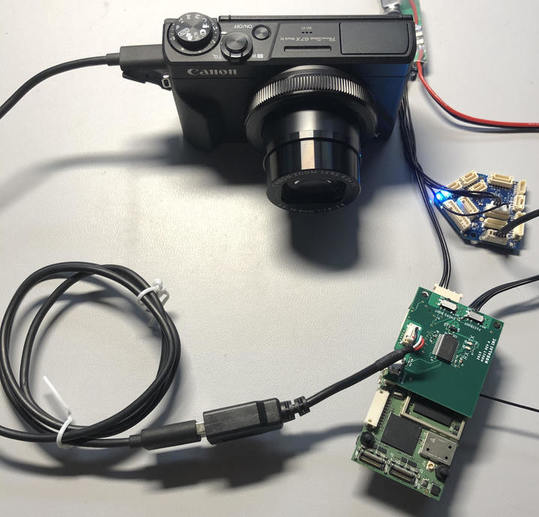How To Stream and Control Popular DSLR Cameras to your VOXL-based Drone
Table of contents
- Overview
- Building voxl-libgphoto2
- Hardware Setup
- Running voxl-libgphoto2
- Customizing FFmpeg parameters
- ModalAI Tested Cameras
Overview
voxl-libgphoto2 enables streaming a live video feed from a wide range of digital cameras to QGroundControl. The following software is used to make this possible.
gPhoto2 is a free, redistributable, ready to use set of digital camera software applications for Unix-like systems, supporting more than 2,500 cameras. These cameras include popular options like Sony A6500, Panasonic DC-GH5, Nikon DSC, Nikon CoolPix, Canon PowerShot, and many more!
FFmpeg is a complete, cross-platform solution to stream video. FFmpeg has a large number of options that can be used to tune the video stream to your liking. On top of the default video encoders, voxl-libgphoto2 supports software encoding using libx264 and hardware encoding using OpenMax.
Building voxl-libgphoto2
Installing necessary files
# On host PC
$ git clone git@gitlab.com:voxl-public/voxl-libgphoto2.git
$ cd voxl-libgphoto2
# With VOXL connected to host PC via. ADB
$ ./push-files-to-target
Building Docker Image
# ADB over to VOXL
$ adb shell
# Enable station mode in order to download dependencies
$ voxl-wifi station [ssid] [password]
# Reboot to save changes
$ reboot
After VOXL has rebooted
# ADB over to VOXL
$ adb shell
# Move to Docker directory
$ cd /data/docker
# Build Docker image
$ docker build -t libgphoto2 libgphoto2/
After build has completed, switch WiFi mode to SoftAP
$ voxl-wifi softap [SSID]
# Reboot to save changes
$ reboot
Hardware Setup
In order to stream a video feed to QGroundControl, voxl-libgphoto2 requires the use of a Flight Core or VOXL Flight.
The following additional hardware is required to stream video from a digital camera through VOXL to QGroundControl.
| Part Number | Description | Link |
|---|---|---|
| MCBL-00009-1 | USB Cable (Host, 4-pin JST to USB 2.0 Type A Female) | Purchase |
| Camera USB Cable | USB Cable included with camera e.g. (USB-C, Mini USB, Micro USB) |
One of the following VOXL Add-on boards is required.
| Part Number | Description | Link |
|---|---|---|
| VOXL-ACC-MH | VOXL Microhard Modem Add-on | Purchase |
| VOXL-ACC-HUB | VOXL USB Expansion Board with Fastboot and Emergency Boot | Purchase |
| VOXL-ACC-LTEH | VOXL Cellular LTE and USB hub add-on | Purchase |
Before beginning setup, make sure the VOXL is disconnected from both it’s power source and it’s USB to host PC cable
Attach the add-on board to the VOXL and make sure that the boot switch(es) are turned off or to the left
Plug the jst side of the MCBL-00009-1 USB Cable into the add-on board
Plug the camera’s USB cable into both the camera and the USB female side of the MCBL-00009-1 USB cable
Power the VOXL

Running voxl-libgphoto2
Starting Docker container
Run a container with the following parameters in order to give voxl-libgphoto2 access to the camera via. it’s USB port.
$ adb shell
$ docker run -i -t --rm -v /dev/bus/usb/:/dev/bus/usb --net=host --privileged libgphoto2
Testing gPhoto2 functionality
The gPhoto docs provide a good explanation on how to use the gPhoto command line interface
Here are a few examples:
$ gphoto2 --list-ports
Devices found: 4
Path Description
--------------------------------------------------------------
ptpip: PTP/IP Connection
ip: IP Connection
serial: Serial Port Device
usb:001,005 Universal Serial Bus
In this example we can see that gPhoto has detected a USB bus on the device. However, we cannot tell yet whether we will have write access to the USB device file your camera will be assigned by the operating system.
The next step is to connect your camera and find out whether gPhoto can find it. This only works with USB.
$ gphoto2 --auto-detect
Model Port
----------------------------------------------------------
Canon EOS 700D usb:001,005
In this case, a camera called “Canon EOS 700D” has been detected on your system’s USB bus.
Next, we can test capturing and image.
$ gphoto2 --capture-image-and-download
New file is in location /capt0000.cr2 on the camera
Saving file as capt0000.cr2
Deleting file /capt0000.cr2 on the camera
This command can be used to take a picture and immediately save the image to the host Docker container instead of the camera.
Streaming video using voxl-libgphoto2
In order to stream a live video feed from the digital camera to QGroundControl, use the following:
$ ./voxl-libgphoto2 192.168.8.XXX
The referenced IP address should be the IP address of the host PC running QGroundControl.
On the host system, while connected to the VOXL’s WiFi network, run QGroundControl
In QGroundControl, press the purple QGC logo in the top left corner in order to access the
Application SettingsmenuUnder the
Generaltab, scroll down until you find theVideosectionUnder the
Video Sourcedropdown, chooseMPEG-TS (h.264) Video StreamIn the
UDP Portfield, enter the default port:4242You will now be able to view the video stream under QGroundControl’s
Flyview
Customizing FFmpeg parameters
By default, voxl-libgphoto2 uses the following basic FFmpeg parameters, specified in the voxl-libgphoto2.py script:
$ ffmpeg -i - -c:v libx264 -f mjpeg udp://192.168.8.XXX:4242
These parameters can be modified to change the stream’s encoder, resolution, bitrate, framerate, etc. as needed.
ModalAI Tested Cameras
The following cameras were tested by ModalAI and successfully used to stream video to QGroundControl:
- Canon EOS 700D
- Canon Powershot G7 X Mark III